[English] 日本語
 Yorodumi
Yorodumi- PDB-3mqp: Crystal Structure of human BFL-1 in complex with NOXA BH3 peptide... -
+ Open data
Open data
- Basic information
Basic information
| Entry | Database: PDB / ID: 3mqp | ||||||
|---|---|---|---|---|---|---|---|
| Title | Crystal Structure of human BFL-1 in complex with NOXA BH3 peptide, Northeast Structural Genomics Consortium Target HR2930 | ||||||
 Components Components |
| ||||||
 Keywords Keywords | APOPTOSIS / bcl-2 family / Structural Genomics / PSI-2 / Protein Structure Initiative / Northeast Structural Genomics Consortium / NESG | ||||||
| Function / homology |  Function and homology information Function and homology informationresponse to dsRNA / positive regulation of extrinsic apoptotic signaling pathway via death domain receptors / positive regulation of endoplasmic reticulum stress-induced intrinsic apoptotic signaling pathway / positive regulation of glucose metabolic process / BH3-only proteins associate with and inactivate anti-apoptotic BCL-2 members / Regulation of MITF-M-dependent genes involved in apoptosis / regulation of mitochondrial membrane permeability / Activation of NOXA and translocation to mitochondria / positive regulation of DNA damage response, signal transduction by p53 class mediator / mitochondrial fusion ...response to dsRNA / positive regulation of extrinsic apoptotic signaling pathway via death domain receptors / positive regulation of endoplasmic reticulum stress-induced intrinsic apoptotic signaling pathway / positive regulation of glucose metabolic process / BH3-only proteins associate with and inactivate anti-apoptotic BCL-2 members / Regulation of MITF-M-dependent genes involved in apoptosis / regulation of mitochondrial membrane permeability / Activation of NOXA and translocation to mitochondria / positive regulation of DNA damage response, signal transduction by p53 class mediator / mitochondrial fusion / Bcl-2 family protein complex / positive regulation of release of cytochrome c from mitochondria / TP53 Regulates Transcription of Genes Involved in Cytochrome C Release / T cell homeostasis / negative regulation of mitochondrial membrane potential / intrinsic apoptotic signaling pathway by p53 class mediator / proteasomal protein catabolic process / cellular response to glucose starvation / Nuclear events stimulated by ALK signaling in cancer / positive regulation of intrinsic apoptotic signaling pathway / extrinsic apoptotic signaling pathway in absence of ligand / intrinsic apoptotic signaling pathway / reactive oxygen species metabolic process / release of cytochrome c from mitochondria / intrinsic apoptotic signaling pathway in response to DNA damage / channel activity / defense response to virus / cellular response to hypoxia / mitochondrial outer membrane / positive regulation of apoptotic process / apoptotic process / DNA damage response / negative regulation of apoptotic process / mitochondrion / nucleus / cytoplasm / cytosol Similarity search - Function | ||||||
| Biological species |  Homo sapiens (human) Homo sapiens (human) | ||||||
| Method |  X-RAY DIFFRACTION / X-RAY DIFFRACTION /  SYNCHROTRON / SYNCHROTRON /  MOLECULAR REPLACEMENT / Resolution: 2.24 Å MOLECULAR REPLACEMENT / Resolution: 2.24 Å | ||||||
 Authors Authors | Guan, R. / Xiao, R. / Zhao, L. / Acton, T.B. / Gelinas, C. / Montelione, G.T. / Northeast Structural Genomics Consortium (NESG) | ||||||
 Citation Citation |  Journal: To be Published Journal: To be PublishedTitle: Crystal Structure of human BFL-1 in complex with NOXA BH3 peptide Authors: Guan, R. / Xiao, R. / Zhao, L. / Acton, T.B. / Gelinas, C. / Montelione, G.T. | ||||||
| History |
|
- Structure visualization
Structure visualization
| Structure viewer | Molecule:  Molmil Molmil Jmol/JSmol Jmol/JSmol |
|---|
- Downloads & links
Downloads & links
- Download
Download
| PDBx/mmCIF format |  3mqp.cif.gz 3mqp.cif.gz | 48.9 KB | Display |  PDBx/mmCIF format PDBx/mmCIF format |
|---|---|---|---|---|
| PDB format |  pdb3mqp.ent.gz pdb3mqp.ent.gz | 34 KB | Display |  PDB format PDB format |
| PDBx/mmJSON format |  3mqp.json.gz 3mqp.json.gz | Tree view |  PDBx/mmJSON format PDBx/mmJSON format | |
| Others |  Other downloads Other downloads |
-Validation report
| Summary document |  3mqp_validation.pdf.gz 3mqp_validation.pdf.gz | 428.4 KB | Display |  wwPDB validaton report wwPDB validaton report |
|---|---|---|---|---|
| Full document |  3mqp_full_validation.pdf.gz 3mqp_full_validation.pdf.gz | 431.1 KB | Display | |
| Data in XML |  3mqp_validation.xml.gz 3mqp_validation.xml.gz | 9 KB | Display | |
| Data in CIF |  3mqp_validation.cif.gz 3mqp_validation.cif.gz | 11.2 KB | Display | |
| Arichive directory |  https://data.pdbj.org/pub/pdb/validation_reports/mq/3mqp https://data.pdbj.org/pub/pdb/validation_reports/mq/3mqp ftp://data.pdbj.org/pub/pdb/validation_reports/mq/3mqp ftp://data.pdbj.org/pub/pdb/validation_reports/mq/3mqp | HTTPS FTP |
-Related structure data
| Related structure data | 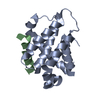 3i1hS S: Starting model for refinement |
|---|---|
| Similar structure data | |
| Other databases |
- Links
Links
- Assembly
Assembly
| Deposited unit | 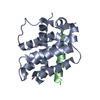
| ||||||||
|---|---|---|---|---|---|---|---|---|---|
| 1 |
| ||||||||
| Unit cell |
|
- Components
Components
| #1: Protein | Mass: 18628.193 Da / Num. of mol.: 1 Source method: isolated from a genetically manipulated source Source: (gene. exp.)  Homo sapiens (human) / Gene: BCL2A1, BCL2L5, BFL1, GRS, HBPA1 / Plasmid: pET15 / Production host: Homo sapiens (human) / Gene: BCL2A1, BCL2L5, BFL1, GRS, HBPA1 / Plasmid: pET15 / Production host:  |
|---|---|
| #2: Protein/peptide | Mass: 2983.468 Da / Num. of mol.: 1 / Fragment: NOXA BH3 peptide, residues 19-43 / Source method: obtained synthetically Details: This sequence occurs naturally in humans. Peptide was synthesized from a commercial peptide synthesis service. Source: (synth.)  Homo sapiens (human) / References: UniProt: Q13794 Homo sapiens (human) / References: UniProt: Q13794 |
| #3: Water | ChemComp-HOH / |
-Experimental details
-Experiment
| Experiment | Method:  X-RAY DIFFRACTION / Number of used crystals: 1 X-RAY DIFFRACTION / Number of used crystals: 1 |
|---|
- Sample preparation
Sample preparation
| Crystal | Density Matthews: 1.95 Å3/Da / Density % sol: 36.79 % |
|---|---|
| Crystal grow | Temperature: 296 K / Method: vapor diffusion, hanging drop / pH: 4.4 Details: Protein solution: 100mM NaCl, 5mM DTT, 0.02% NaN3, 10mM Tris-HCl (pH 7.5) . Reservoir solution: 1.5 M Sodium Malonate, 0.1 M sodium Acetate, VAPOR DIFFUSION, HANGING DROP, temperature 296K |
-Data collection
| Diffraction | Mean temperature: 100 K |
|---|---|
| Diffraction source | Source:  SYNCHROTRON / Site: SYNCHROTRON / Site:  NSLS NSLS  / Beamline: X29A / Wavelength: 1.075 Å / Beamline: X29A / Wavelength: 1.075 Å |
| Detector | Type: ADSC QUANTUM 315r / Detector: CCD / Date: Apr 23, 2010 |
| Radiation | Monochromator: Si 111 CHANNEL / Protocol: SINGLE WAVELENGTH / Monochromatic (M) / Laue (L): M / Scattering type: x-ray |
| Radiation wavelength | Wavelength: 1.075 Å / Relative weight: 1 |
| Reflection | Resolution: 2.24→30.3 Å / Num. all: 7559 / Num. obs: 7385 / % possible obs: 97.7 % / Observed criterion σ(F): 2 / Observed criterion σ(I): 2 / Redundancy: 5.9 % / Biso Wilson estimate: 45.125 Å2 / Rmerge(I) obs: 0.093 |
| Reflection shell | Resolution: 2.25→2.33 Å / Redundancy: 4.6 % / Rmerge(I) obs: 0.383 / Mean I/σ(I) obs: 3.06 / Num. unique all: 643 / % possible all: 84.6 |
- Processing
Processing
| Software |
| ||||||||||||||||||||||||||||||||
|---|---|---|---|---|---|---|---|---|---|---|---|---|---|---|---|---|---|---|---|---|---|---|---|---|---|---|---|---|---|---|---|---|---|
| Refinement | Method to determine structure:  MOLECULAR REPLACEMENT MOLECULAR REPLACEMENTStarting model: PDB ENTRY 3I1H Resolution: 2.24→30.3 Å / σ(F): 2 / σ(I): 2 / Stereochemistry target values: ML
| ||||||||||||||||||||||||||||||||
| Solvent computation | Shrinkage radii: 0.83 Å / Solvent model: FLAT BULK SOLVENT MODEL | ||||||||||||||||||||||||||||||||
| Displacement parameters | Biso mean: 52.987 Å2 | ||||||||||||||||||||||||||||||||
| Refinement step | Cycle: LAST / Resolution: 2.24→30.3 Å
|
 Movie
Movie Controller
Controller


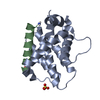
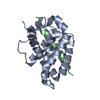
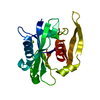


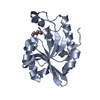
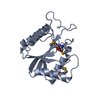
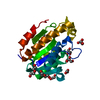
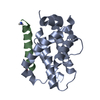
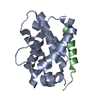
 PDBj
PDBj






